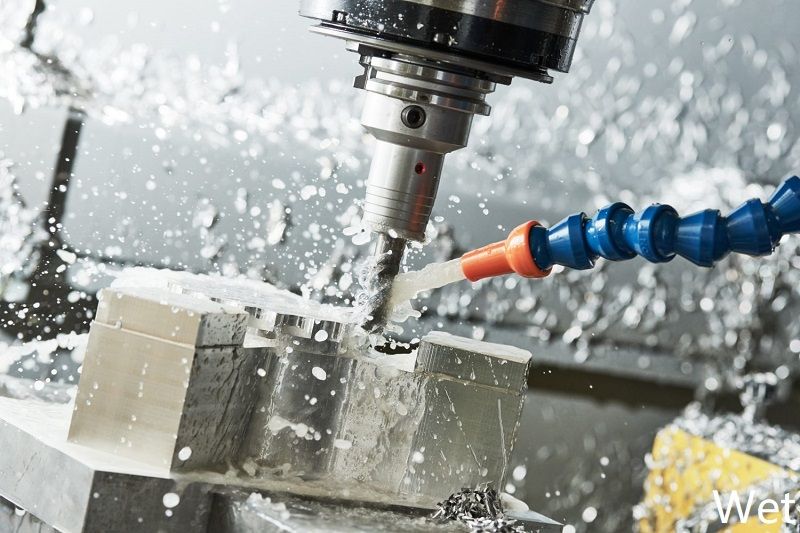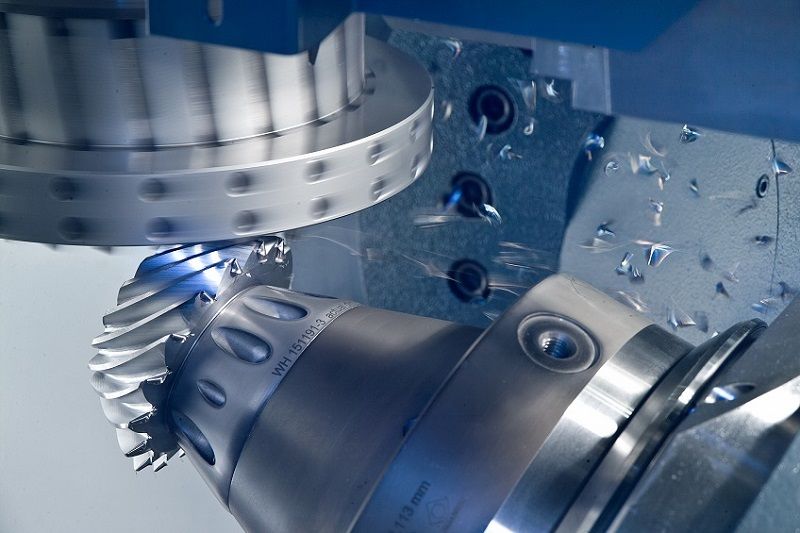
Production
managers in manufacturing often have to ask themselves: should we continue with
conventional machining and coolant lubricants, or do dry machining or minimum
quantity lubrication (MQL) represent viable alternatives? Several factors
influence this decision. In Part 1 of this two-part series of technical
articles being published in the run-up to EMO Hannover 2019, lubrication system
experts and scientists give their assessment. Tool and machine manufacturers
shed light on the subject in the second part.

PART 1
Very
high temperatures are generated in the cutting zone during machining. Coolant
lubricants reduce friction, provide cooling (but may also cause destructive
thermal shocks) and support the removal of chips. Back at the turn of the
millennium, some experts predicted dry machining would make a breakthrough as a
substituting process. It is now time to assess the current position. In which
areas have this process, or minimum quantity lubrication (as quasi-dry
machining) become established, and to what extent? In this two-part technical
report, lubrication system manufacturers, machine and tool suppliers and
scientists provide a comprehensive assessment from various perspectives and
identify the advantages and disadvantages of the respective technologies.
Particular
relevance for series machining
“The main area of application for minimum quantity lubrication lies
in the machining of prototype parts as found in large-scale series production
in the automotive industry – especially of powertrains. The parts range from
the cylinder head and engine block to the crankshaft or camshaft, connecting
rod, gearbox and wheel carrier, etc.,” says Jürgen Keppler in Technical Sales
at bielomatik Leuze GmbH + Co. KG in Neuffen. The Baden-Württemberg-based
engineering company is a recognised specialist in the development and
manufacture of high-quality MQL systems. “Further industrial applications
include the machining of cubic components and mechanical engineering castings
such as fittings, pump housings or valves. It is a great advantage in the
aviation industry, too, if complex components are not flooded with emulsion.”
The
expert estimates that MQL is used for machining about 15 per cent of new
large-series components, rising to 70 per cent for deep hole drilling in
crankshafts, for example. “MQL will continue to grow in the other application
areas I just mentioned,” says Keppler, convinced. “The upswing in MQL machining
predicted some 20 years ago has mainly occurred in the automotive sector. Here,
the advantages of MQL could be fully exploited in the machining of cast and
forged parts. The high quantities involved also allowed the related R&D
work to be carried out. New application areas will also arise from the
forthcoming changes in e-mobility and additive manufacturing. The great
advantage of MQL lies in the cost savings to be made in resources such as oil,
water and energy.” Further advantages are dry workpieces, no carry-over of
emulsion and contamination in the production bays, and the prevention of
associated health risks. “The constant further development of materials and
applications is placing new demands on machining processes and thus on MQL
systems. This will certainly result in interesting solutions,” says Keppler.
What
do the scientists say?
“Thanks to modern cutting materials, dry machining has been
introduced in almost all areas of machining production. Increasing cost
pressure, but also energy consumption and ecological aspects are leading to a
renaissance of these technologies,” says Dr. Ivan Iovkov Head of Cutting
Technology at the Institute of Machining Technology ISF of the Technical
University of Dortmund. “Dry machining is not only used in conventional milling
or turning. There are also efforts to minimise or completely avoid the use of
coolant lubricants in complex processes such as deep drilling and gear hobbing.
However,
the cutting processes and the technology still need to be adapted in certain
ways.” Dry machining tends to be more common in big companies which process
larger quantities than in smaller companies which specialise in varying types
of high-precision and complex components.
“I think there will be both dry and wet machining in the future,” he
predicts. “We need to take a holistic view of production when deciding whether
dry machining makes sense or whether it will involve disproportionately high
process adaptation costs. The continuous further development of MQL device
technology and coatings, the increasing accuracy of the machine park, but also
digitalisation – for example through in-process sensor monitoring of relevant
variables – will make it possible in the future to carry out more and more dry
or MQL machining under robust practical conditions.”
Summary
It
is too soon to speak of conventional machining processes being comprehensively
replaced by dry machining or minimum quantity lubrication, as wet machining
(involving larger quantities of coolant lubricant) still accounts for an
estimated 85 per cent of machining. Nevertheless, dry processes are conquering
more and more areas, both in the general machining sector and above all in
special areas. In the second part of the article, tool and machine
manufacturers take a practical view of the different production technologies
and recommend adopting a holistic approach. Trade visitors to EMO Hannover 2019
will find extensive information and support which can help them find the right
technology for their own individual applications.
PART 2
Should
we continue with classic machining and coolant lubricants, or do dry machining
and minimum quantity lubrication (MQL) represent viable alternatives? From a
technology point of view, it is important to consider material properties and
machine performance, but plant costs, energy and health aspects increasingly
need to be included in any assessment of the overall process. Lubrication
system manufacturers and scientists com-mented on these aspects in the first of
this two-part series. Part 2 now looks at various machining technologies from
the practical perspective of tool and machine manufacturers: a preview of EMO
Hannover 2019.

Dry
machining has conquered the field of gear manufacturing, as predicted. Cutting
speeds are up to 5 times higher than those of wet machining 20 years ago.
Photo: Klingelnberg
Over
twenty years ago, some experts predicted a triumphant future for dry machining.
In which areas have dry machining and minimum quantity lubrication become
established?
Gear
hobbing now exclusively dry
“The advantages of MQL over wet machining lie in the lower costs for
the cooling lubricant and the elimination of chemical additives in the lubricant.
This results in cost advantages, and also fewer adverse health effects for the
employees,” says Dr. Hartmuth Müller, Head of Technology & Innovation at
Klingelnberg GmbH’s Hückeswagen production site. The mechanical engineering
company, headquartered in Zurich (Switzerland), employs around 1,300 people
worldwide and specialises in bevel and spur gear technology.
“The principle behind MQL is based on wetting the rake face. This is
easy to achieve with internally cooled tools, while it is not feasible with the
complicated tool geometries of gear cutting tools. For this reason,
Klingelnberg relies exclusively on dry machining for gear hobbing. We only use
MQL when machining cast components for use in engineering.” Tungsten carbide
bar cutting tools are deployed for bevel gear milling. For cost reasons,
tungsten carbide tools are not widely used for spur gear milling; dry-cut
PM-HSS hobs are generally used for this purpose. The subsequent hard finishing
of gear wheels is carried out – whenever possible – by grinding, using oil as
coolant lubricant.
“Dry machining has definitely triumphed in gear manufacturing, as
predicted,” says Dr. Müller. “Thanks to developments in cutting materials and
coatings, cutting speeds are up to five times higher than they were with wet
machining 20 years ago. Dry machining has not only led to a considerable
increase in productivity, but also to cleaner production.” At EMO Hannover,
Klingelnberg will demonstrate its highly proficient ranges for the gearing
industry, including the development and manufacture of machines for gear
production, precision measuring centres for all kinds of rotationally symmetric
objects and the manufacture of custom-made, high-precision gear components.
Cost-efficient
and environment-friendly
Hartmetall-Werkzeugfabrik
Paul Horn GmbH from Tübingen is one of the leading tool manufacturers. “MQL has
replaced conventional coolant lubricants in some machining processes,” says
Managing Director Lothar Horn. “Cooling and lubricating using minimum quantity
lubrication offer users a number of advantages. This has led to MQL being used
in many machining operations, particularly in series production. This type of
cooling reduces the high costs in the maintenance, preparation and disposal of
conventional coolant lubricants. In addition, it eliminates the energy costs
for the high-pressure pumps and feed pumps required for returning lubricants to
the collection basin. In addition, the government is imposing stricter
requirements on coolant lubricants with regard to hazardous ingredients. In
spite of the advantages of MQL I just mentioned, conventional coolant lubricants
are indispensable in production facilities. Many processes – such as drilling,
machining of high-temperature alloys, or internal machining with high chip
removal rates – require an adequate supply of conventional cooling lubricant.”
At EMO Hannover 2019, the tool specialists will be showcasing their extensive
turning, milling, slotting and reaming portfolios as well as their ranges of
ultra-hard cutting materials and special tools, etc.
Planning
dry machining correctly
“In Grob machines, dry or MQL machining is used for processes with a
geometrically defined cutting edge such as drilling, milling or roughing,”
reports Jochen Nahl, CSO of Grob-Werke GmbH & Co. KG from Mindelheim.
“Typical workpieces are frame structure or chassis parts, combustion engine and
drive train components made of aluminium or grey cast iron, and now also
turbocharger housings made of highly heat-resistant cast steel. Wet machining
is still very much part of the DNA of many companies, yet the share of MQL
machines has already increased to 12 per cent in recent years and is continuing
to rise, especially for the machining of frame structure and chassis parts.”
The family-owned company has a total workforce of around 6,900 employees
worldwide and has been a pioneer in the construction of highly innovative
production and automation systems for more than 90 years. “The advantages of
MQL machining speak for themselves,” continues Jochen Nahl. “Production line
investment costs can be lowered and the effort involved in cleaning the
work-pieces can be reduced significantly. In addition, MQL uses around a
quarter less energy compared to wet machining.”
Although
dry machining is not currently being deployed to the extent that was expected,
it is clear that industry is gradually accepting it. “If the benefits are to be
reaped, any switch from wet to dry machining should be based on an intelligent
strategy and implemented with a competent ma-chine supplier as a partner,”
recommends CSO Nahl. “Modern companies are already benefitting from recent positive
developments such as temperature compensation, the use of higher air pressure
levels, and modular systems that reduce manufacturing costs and avoid
unnecessary over-engineering. The global player, with headquarters in
Mindelheim (Bavaria), will showcase its current portfolio, conduct live
machining demonstrations and present other technical highlights at this year’s
EMO in Hanover.
Conclusion
and outlook
Wet
machining involving larger quantities of cooling lubricant is still used for
the vast majority of machining processes. Nevertheless, dry machining and
minimum quantity lubrication are on the advance, especially in special areas
such as gear hobbing.
In
addition to technological aspects (such as workpiece materials and machine performance),
potential cost savings for energy and systems play an important role in
selecting the appropriate process. In addition, health aspects, sustainability
and stricter legal requirements are being accorded ever greater weight as
factors within the overall assessment. Technological advances and detailed knowledge
of the cutting edge processes will offer more and more possibilities in the
future for safe and (in many cases also) highly productive dry machining and
MQL. At EMO Hannover 2019, trade visitors will find in-depth information,
suggestions and help in making the right choice between wet and dry machining
and MQL for their own applications.
Author:
Dag Heidecker, daxTR – Technik + Redaktion, Wermelskirchen——VDW


